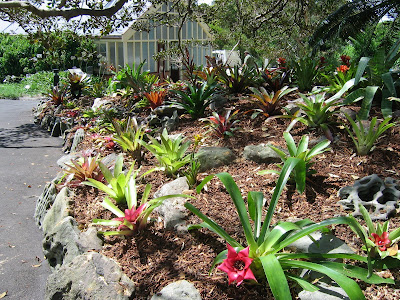Big Broms (Passion for Plants*)

This newly planted garden at the Royal Botanic Gardens has 200 different kinds of bromeliad
*This posting will also appear on the ABC Sydney website (possibly under 'gardening'), and is the gist of my radio interview with Simon Marnie on Saturday Morning, 30 May, sometime between 9-10 am on 702AM.
We have a new collection of bromeliads under our Port Jackson Fig near the Palm House. This is nineteenth century rockery is listed as a ‘significant cultural landscape’ in the Royal Botanic Gardens, and we’ve refreshed it with stock from a nursery in Queensland. It’s had bromeliads in it for at least the last 25 years and probably longer.
There are more than 200 new kinds of bromeliad, including 37 species we haven’t had before, and four new genera for the Gardens. We now have more than 300 different species and another 200 or so cultivars of bromeliad in the Royal Botanic Gardens – a total of 1330 individual broms.
We’ve also included a few of the larger bromeliads once grouped together in a genus called Vriesea, but now separated out into Alcantarea and Werauhia.
We already have some big red Alcantarea imperialis at the top of the vertical wall near the Tropical Centre, and some spectacular Alcantarea extensa around the Wishing Tree on the other side of Macquarie Wall.
These big bromeliads can have flowering stems a metres high. In fact the biggest flowering structure in the world is found on the rare Bolivian bromeliad, Puya raimondii. It has flower cluster is over 2 m wide and 10 m high – that’s a large truck on its end. Each cluster can have 8000 or more flowers.
This gigantic ‘inflorescence’ emerges after about 150 years, and once its finished flowering, the plant dies.
At the other end of the spectrum is the Spanish Moss (Tillandsia usneoides), with its tiny leaves and flowers. Collectively though, it can produce large masses hanging from trees and bushes, as it does in many of our gardens. There are also some bigger species of Tillandsia, and we have the popular and pretty Tillandsia jaliscomonticola in our new collection.
The best known bromeliad is probably the pineapple, but there are more than 3,500 species in the plant family Bromeliaceae, all of them native to the Americas.
Many bromeliads live in trees, getting their water from the air or what they hold in the ‘tanks’ in the middle of their tuft of leaves. The biggest of these tanks can hold up to 20 litres or more, and can contain a whole ecosystem of frogs, insects, and even other plants.
They are great tough plants for a drying environment and many – but not the pineapple - will grow outdoors in Sydney.
There are more than 200 new kinds of bromeliad, including 37 species we haven’t had before, and four new genera for the Gardens. We now have more than 300 different species and another 200 or so cultivars of bromeliad in the Royal Botanic Gardens – a total of 1330 individual broms.
We’ve also included a few of the larger bromeliads once grouped together in a genus called Vriesea, but now separated out into Alcantarea and Werauhia.
We already have some big red Alcantarea imperialis at the top of the vertical wall near the Tropical Centre, and some spectacular Alcantarea extensa around the Wishing Tree on the other side of Macquarie Wall.
These big bromeliads can have flowering stems a metres high. In fact the biggest flowering structure in the world is found on the rare Bolivian bromeliad, Puya raimondii. It has flower cluster is over 2 m wide and 10 m high – that’s a large truck on its end. Each cluster can have 8000 or more flowers.
This gigantic ‘inflorescence’ emerges after about 150 years, and once its finished flowering, the plant dies.
At the other end of the spectrum is the Spanish Moss (Tillandsia usneoides), with its tiny leaves and flowers. Collectively though, it can produce large masses hanging from trees and bushes, as it does in many of our gardens. There are also some bigger species of Tillandsia, and we have the popular and pretty Tillandsia jaliscomonticola in our new collection.
The best known bromeliad is probably the pineapple, but there are more than 3,500 species in the plant family Bromeliaceae, all of them native to the Americas.
Many bromeliads live in trees, getting their water from the air or what they hold in the ‘tanks’ in the middle of their tuft of leaves. The biggest of these tanks can hold up to 20 litres or more, and can contain a whole ecosystem of frogs, insects, and even other plants.
They are great tough plants for a drying environment and many – but not the pineapple - will grow outdoors in Sydney.
Comments